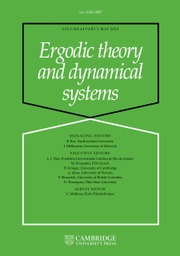Article contents
Non-holonomic systems as singular limits for rapid oscillations
Published online by Cambridge University Press: 30 September 2002
Abstract
In this paper, we point out a close relationship between two standard classical problems in mechanics which have coexisted in textbooks for many decades: (1) the pendulum whose suspension point executes fast periodic motion along a given curve; and (2) the skate (known also as the Prytz planimeter, or the ‘bicycle’). More generally, we deal with dynamical systems subjected to rapidly oscillating forcing. Examples include: charged particles in rapidly oscillating electromagnetic fields, in particular the Paul trap; particles in an acoustic wave; a bead sliding on a rapidly vibrating hoop. It turns out that the averaged systems of such kind are approximated by a non-holonomic system. The holonomy turns out to have a transparent geometrical or physical interpretation. For the example of a particle in an acoustic wave the holonomy is directly proportional to the speed of the vibration-induced drift.
Information
- Type
- Research Article
- Information
- Copyright
- © 2002 Cambridge University Press
- 2
- Cited by

